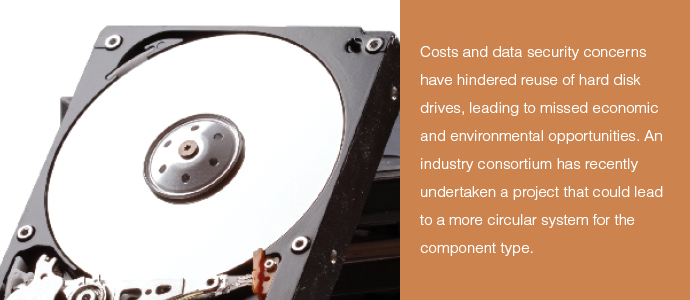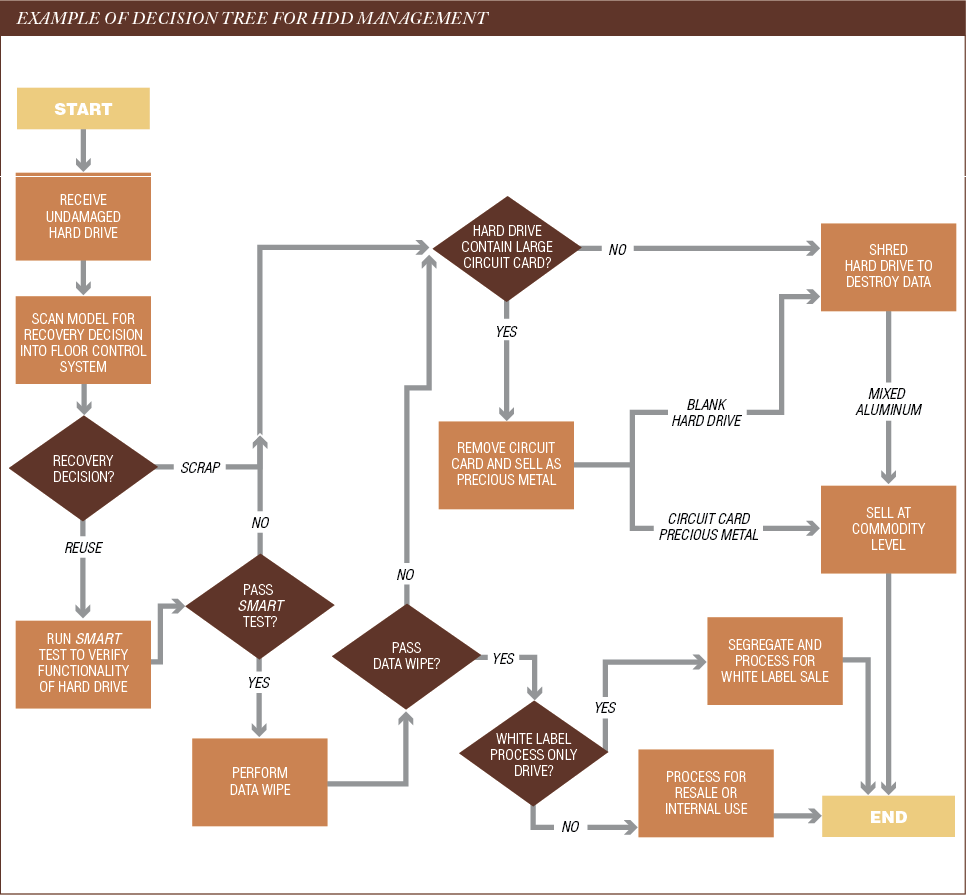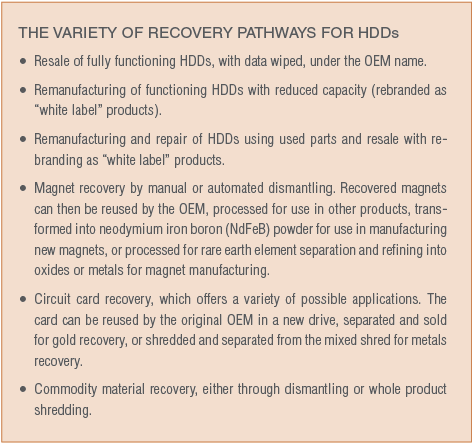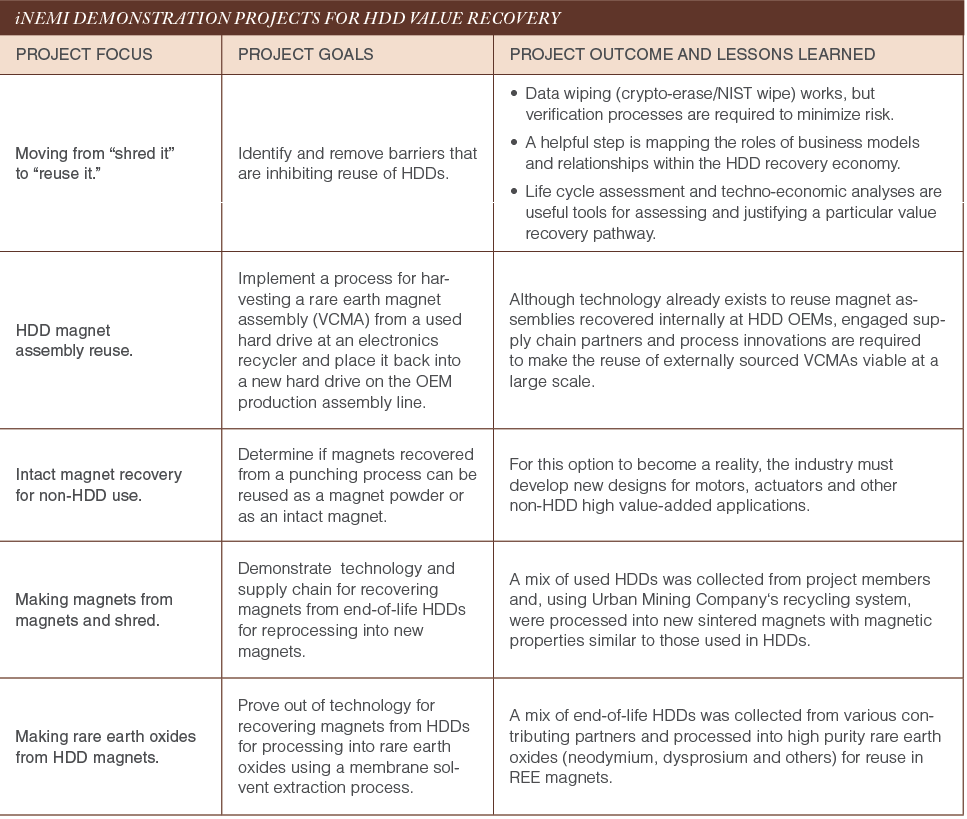
This article originally appeared in the Winter 2018 issue of E-Scrap News. Subscribe today for access to all print content.
The expanding demand for electronic products is good for the electronics industry worldwide, but the market reality is also increasing resource consumption by way of products that have intrinsically short life spans. However, many leading electronics manufacturers have tried to start to modify their business practices and transform from a linear economy – based on the traditional “take-make-waste” model – to a circular one that will return more resources into the supply chain.
To help move forward those goals around smarter resource use, the International Electronics Manufacturing Initiative (iNEMI) has been bringing together the required components of sustainability – economic, environmental and societal – to realize a circular economy for hard disk drives (HDDs). Using HDDs as a first target, the iNEMI’s “Value Recovery from Used Electronics” project has been working to improve the economics of value recovery across product life cycles, aiming to spur conservation of resources and increases in profitability for a variety of stakeholders.
This article discusses the HDD project’s findings and outlines specific pathways needed to make progress toward a more circular future for these critical electronic components.
Why hard disk drives?
The iNEMI is an industry-led consortium of electronics manufacturers, suppliers, industry associations, government agencies, research institutes and universities. The objective of the initiative is to offer a roadmap to fulfill the needs of the electronics industry by identifying critical voids in the technology infrastructure and establishing implementation projects to eliminate those gaps.
HDDs are good candidates for a sustainable electronics project in part because the demand for data storage is outpacing the ability of HDD and SSD manufacturers to offer supply. There are a number of ways to fill this gap: continued investment in technology, increased HDD reliability, and increased reuse of used HDDs and their subsystems.
The secondary market for HDDs is flourishing as data wiping processes proliferate, and now millions of functioning HDDs are resold each year. However, there are severe barriers that are hindering reuse and recovery options from reaching their full potential. The most significant barriers are perceived data security risks (leading to the destruction of perfectly reusable drives), technological challenges associated with HDD separation, and a lack of coordination between stakeholders in the supply chain.
One of the major weaknesses of the current recycling system is that recovery is generally limited to only a few options. Individual recovery operators focus on a subset of opportunities, based on their core expertise and experience as well as economic factors. However, when it comes to handling recovered HDDs, multiple value-generating pathways exist, and it is likely that few recycling facilities are currently equipped to identify and leverage of them.
That means that value recovery – meaning potential revenue – is being left on the table.
 It is that reality that the iNEMI HDD project strives to address. How can the electronics recovery sector pivot to ensure that this material is maximized, both in terms of economics and the environment?
It is that reality that the iNEMI HDD project strives to address. How can the electronics recovery sector pivot to ensure that this material is maximized, both in terms of economics and the environment?
In Phase 1 of the project, a small survey was conducted to better understand current practices, barriers to greater recovery and economic viability. The survey included an HDD manufacturer, HDD users, used HDD processors, recyclers, researchers and others.
Those actors identified the following barriers to maximizing recovery value:
- Demand by last user for physical destruction, eliminating disassembly and reuse options.
- Lack of reliability assurances for data wiping.
- Lack of economically viable collection.
- Expense of dismantling.
- Lack of standardization of parts or quality standards for reuse.
- The survey findings were important inputs for Phase 2 of the project, during which iNEMI brought together a team of individuals and organizations representing the full supply chain for value recovery for HDDs.
The specific stakeholders included the following companies and institutions:
- Seagate, an HDD OEM that also has connections to magnet manufacturers.
- Cisco, an OEM of electronic products.
- Google and Microsoft.
- A number of IT asset management companies, including Cascade Asset Management, Echo Environmental, Geodis and Teleplan.
- Urban Mining and Momentum Technologies, both of which are engaged in metals and magnet value recovery.
- Major research institutions, including Purdue University as well as the U.S. Department of Energy’s Critical Materials Institute, Ames Laboratory, Idaho National Laboratory and Oak Ridge National Laboratory.
- EPEAT, a sustainable electronics labeling organization.
A major goal of the “Value Recovery” project is to provide the information needed for businesses to make the best decisions when handling used HDDs. These products embody a variety of characteristics: manufacturer, age, condition, wishes of last use and more. A series of decision points, based on individual unit characteristics, with appropriate parameters and tests, can direct units down the optimal pathway to value recovery.

The first step in understanding how to progress was constructing a set of “decision trees” to identify the options for value recovery and what information recyclers and others need to move toward a higher value recovery. As shown in the decision tree chart above, each decision point in the processing chain represents an opportunity to maximize value recovery. The flow frequently begins with the HDD owner, who will often answer the question “To shred, or not to shred?” before even sending the products to disposition.
After the decision tree around HDD management was sketched out, the project team moved to develop economic and logistics models to determine which value recovery options generated the highest profit by type and size of drive.
Then, through five demonstration projects, the team delved deep into some of the toughest challenges in creating new pathways for value recovery. The goals and outcomes of each demonstration project are presented in the table below.
Finding path to close the loop
The work that this project began is not finished, and the team is committed to carrying on and helping to create the supply chains necessary to make better use of recovered HDDs a reality.
Some important lessons have become clear.
Perhaps most critical is the need for more engaged conversation around shredding and data security. If shredding is the option utilized, circuit boards are sometimes removed to separate them for gold recovery. But after shredding, the only remaining value recovery option is to send the shred for mixed aluminum recycling. If wiping and reuse are allowed, then significantly higher revenue may be possible from selling the drives.
For a drive owner that is considering disposition, data security and cost are generally the top two considerations, and both of these factors can be managed through wiping and verification. But even with good technical solutions, a key factor will still be the organizational policy of the owner of the drive. Such policies often favor the most extreme destruction pathway. Capabilities of the recycler to carry out a state-of-the-art wiping process, including chain of custody and verification, are paramount and essential to building trust between owners and recyclers. This trust opens the door to greater value recovery for both owners and recyclers.
The project team carefully examined the full range of data sanitization options. These included use of firmware-based remanufacturing, physical data wiping, replacing the encryption key for self-encrypting drives (SEDs), and physical destruction by shredding and degaussing. The necessary conditions for choosing specific options were analyzed and findings were incorporated into the decision trees.
Ultimately, the team would like to eliminate shredding as the default option for HDD disposition. So many more options are currently available, and new ones will become available as the iNEMI project team creates new value recovery pathways.
Another important discussion that needs to take place relates to product design. Electronic device design that facilitates removal and disassembly is necessary for recovery and reuse of whole units and parts, especially when automated disassembly can be employed. Designs might include, for example, fasteners that are easier to manipulate for disassembly, a standardized system of fastener location, and materials that are easily liberated.
A final area that needs improvement is critical materials recovery. Critical and strategic materials, especially rare earth elements, are not recovered in today’s recycling infrastructure. For instance, neodymium iron boron (NdFeB) is a permanent magnet with the highest energy density currently available – the substance plays a key role in electric motors, generators, HDDs and other products. With increasing demand for neodymium (demand is projected to increase by up to 700 percent in the coming 25 years, especially for clean energy technologies), it is important to recover these materials whenever possible.
The primary cause of the low recovery rate for neodymium and several other critical and strategic materials in other types of products is that they occur in relatively small quantities in individual units. They also require new and often relatively expensive methods of liberation from the product and refinement into a usable form. This issue is being addressed by iNEMI through its collaboration with the Critical Materials Institute.
 All in this together
All in this together
To achieve a circular economy in HDDs, the stakeholders in the chain of commerce – including HDD manufacturers, users and asset disposition managers – will need to add new dimensions to their business models, which in some cases, will require additional investment. The return on those investments can only be assured if other stakeholders in the chain also make corresponding changes.
Notably, each individual stakeholder in the chain will have different opportunities, requiring different types of levers. But the first essential ingredient is an economically and technically sound model of value recovery covering the entire system that is visible to all actors. This model must depict how money and product would flow through the variety of functions that different individual stakeholders could perform.
What are the tools of leverage? There are (at least) three types of tools, all based around the sharing of information: structured discourse, technical documentation and specifications.
The structured discourse category includes elements such as iNEMI projects, workshops and webinars, and partnership agreements. Examples of technical documentation are decision trees that lay out recovery options, design guides to facilitate product recoverability, and best practice guidelines for processing. Finally, in the specifications realm, we have industry norms and voluntary industry agreements, purchasing specifications by institutional buyers, EPEAT and other product standards, and recovery system standards, including R2 and e-Stewards.
All of those mechanisms can be used to connect stakeholders and enact best practices to drive smarter recovery of HDDs and other electric products and components.
The iNEMI “Value Recovery” project team is continuing its work and is considering the formation of a Phase 3 project to maintain the momentum created in Phase 2. The objectives would be:
- Implement all the pathways identified in Phase 2 for value recovery.
- Provide greater guidance for validation and verification of data wiping solutions for organizations of all sizes and current business models.
- Establish stakeholder relationships to put recovered rare earth elements back into HDD supply chains.
- Expand the options for creating “hard drives from hard drives.”
The iNEMI project team welcomes your participation in Phase 3 and hopes to continue being a resource for the recycling industry in increasing both value recovery for HDDs and stakeholder profits.
Wayne Rifer is retired director of research and standards at EPEAT and the Green Electronics Council, and he is a project leader for iNEMI. In writing this article, he was supported by iNEMI project team members. Industry stakeholders wanting to learn more about the “Value Recovery from Used Electronics” initiative can contact Mark Schaffer at [email protected].


 All in this together
All in this together